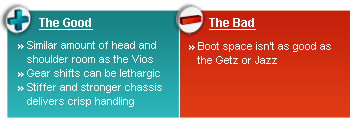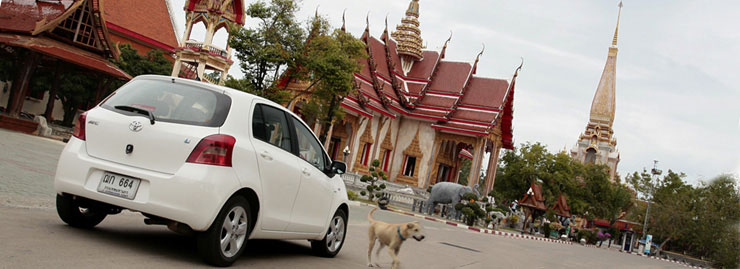Road Trip - Toyota Yaris Gasohol E-20 in Phuket
09 Feb 2009|21,895 views
 |
The Yaris is also made in Thailand, taken after the Japanese-made Vitz. You will at any point of time, see hundreds of them fly by in an attempt to make quick with traffic.
Yes, average road speeds in Thailand are surprisingly rapid, and locals make no reservations about negotiating the occasional dusty track in their new generation of compact cars with much gusto. Where Toyota Hiluxes, Isuzu Troopers and other four-wheel driven monsters once dominated the Southern Thai region, a smaller and more fuel-efficient class of cars are fast taking over the ironed-out back-roads and main highways.
They play a pivotal role in the changing face of Thailand's road transport system and in this case, Phuket's extensive post-Tsunami resort cum land development efforts.
Anyway, back to the car. Amongst the likes of the new Honda Jazz, Nissan March and other econo-hatches found in Singapore, the Yaris has aged surprisingly well. The strong mono-boxed shape features brief overhangs, a black front grille housed between vertically descending lines and large headlamps that extend upwards to the windshield, all giving it a youthful appearance.
The equally large tail lamps flank a boot-lid that opens up to rather disappointing amounts of cargo space that's easily surpassed by both the Hyundai Getz and Honda Jazz with the seats up. Part of this might have to do with the car's "Easy Flat" concept. Release a catch in one single motion and the seats quickly stow downwards, forming a flat space from the boot entrance into the rear passenger compartment.
The seat cushions and head restraints don't have to be removed, and the front seats can be left in their rearmost position if required. Well something had to give, and this came in the form of a higher-than-usual cargo floor.
 |
But when the seats were in their normal user-friendly positions, surprisingly good amounts of head, shoulder and leg room were to be had. It's about the same as what you might find in a Toyota Vios, and definitely more than in the outgoing Honda Jazz.
Like in the Vios, the instrument dials sit atop the centre console, leaving a strange void ahead of the steering wheel. For the money in this basic-spec, "E" variant, you'll get white-on-black looking cluster readout with a LED fuel gauge indicator." Standard equipment includes a tilt steering wheel, gated automatic shift lever, map reading lights, intermittent wipers with mist control, two sun visors and vanity mirrors. There were ample storage bins and cup holders - something which we valued during our trip.
Performance
The only engine available in the Yaris so far is of course, the 106-horsepower, 1.5-liter 1NZ-FE four-cylinder with "intelligent" variable valve timing, or VVT-i as Toyota likes to call it. The same engine can be found in the Toyota Rush-G, Allion and Vios. The only difference between our tester and the Singapore selling Yaris, is that this car runs on Gasohol E-20, which simply means 91-octane petrol mixed with 20-percent of alcohol.
A litre of Gasohol costs just under 16 Bhat, which roughly translates to only S$0.70. In comparison, a litre of normal 91-octane gasoline costs around 23 Bhat, or just under S$1.00.
There was a catch though, and that came in the slight reduction of fuel economy. Under moderately-paced driving through hilly terrain, we returned just under 10 km/l, or 398 km from the 40-litres of petrol.
Most of this had to with steep, uphill gradients normally associated with Phuket's magnificent cliff-side roads from Kata beach towards the Promthep cape. Along with other easily accessible routes that were prominently marked, they guarantee one of the most scenic drives in the region.
This would also be a good time to highlight the four-speed automatic, which had a lock-up torque converter and a "Shift Logic" system that Toyota claims, helps reduce unnecessary shifting during uphill and downhill driving situations.
We felt very little difference though, especially when driving briskly. The transmission took quite a while to realize that it was already on a steep slope before it started downshifting or holding the gears. By the time it did so, precious speed was bled off and the Yaris had lost its momentum. On the upside, first gear was extremely peppy. We had no problem whatsoever, overtaking slower moving vehicles on pronounced up-hills at speeds of up to 60 km/h.
 |
Driving impressions
When driven through this sort of terrain, the Yaris still demands that you make your own shift choices with the gated shifter. But fret not, because the car was fun to drive. A rigid L-arm MacPherson strut front design and hydro-formed rear torsion beam provides adequate anti-roll stabilization, eliminating the need for a separate anti-roll bar. Combined with a tighter steering ratio, it was a joy through any tight sequence of corners in true hatch style.
The electrically-assisted power steering was devoid of feedback, which again emphasises my point on today's cars having excellent handling capabilities but poor steering communication - all done in the name of comfort, perhaps.
On flatter surfaces that hit closer to home, pickup was more than adequate off the lights, and on standard 185/60 profile 15 inch rims and wet weather tyres, the Yaris was surprisingly quiet, save for some road noise at highway cruising speeds of up to 110 km/h. There was also a little bit of wind noise when pushed beyond.
Is it still good?
Compared to the Echo? Yes, definitely. In terms engineering advances, the Yaris is stiffer, its chassis stronger and as a result, delivers much-improved ride and crisp handling with a class-leading turning circle. Amongst today's offerings such as the new Honda Jazz, the Yaris might be left a little wanting in the department of space and overall finish. But fret not, as it will be undergoing a mid-life, minor facelift, and it will be significantly lower priced. When you consider that it still has the overall quality to put up a good fight, that's definitely something to look forward to.
--------------------------------------------------------------------------------------------------------------------------------------------------------------------------------------
 We would like to thank Avis Thailand, and Avis Singapore for arranging our Toyota Yaris test car. It's also available for rent throughout Thailand. In Phuket, its ability to run on Gasohol E-20 also makes it one of the cheapest, most fuel efficient budget cars available at a reasonable cost. We also found a great piece of mind when considering its low, 8000 bhat excess, and for the fact that we didn't have to deal with unscrupulous "back-road" dealers who may potentially rent accident-damaged vehicles, sans the black and white.
We would like to thank Avis Thailand, and Avis Singapore for arranging our Toyota Yaris test car. It's also available for rent throughout Thailand. In Phuket, its ability to run on Gasohol E-20 also makes it one of the cheapest, most fuel efficient budget cars available at a reasonable cost. We also found a great piece of mind when considering its low, 8000 bhat excess, and for the fact that we didn't have to deal with unscrupulous "back-road" dealers who may potentially rent accident-damaged vehicles, sans the black and white.  |
The Yaris is also made in Thailand, taken after the Japanese-made Vitz. You will at any point of time, see hundreds of them fly by in an attempt to make quick with traffic.
Yes, average road speeds in Thailand are surprisingly rapid, and locals make no reservations about negotiating the occasional dusty track in their new generation of compact cars with much gusto. Where Toyota Hiluxes, Isuzu Troopers and other four-wheel driven monsters once dominated the Southern Thai region, a smaller and more fuel-efficient class of cars are fast taking over the ironed-out back-roads and main highways.
They play a pivotal role in the changing face of Thailand's road transport system and in this case, Phuket's extensive post-Tsunami resort cum land development efforts.
Anyway, back to the car. Amongst the likes of the new Honda Jazz, Nissan March and other econo-hatches found in Singapore, the Yaris has aged surprisingly well. The strong mono-boxed shape features brief overhangs, a black front grille housed between vertically descending lines and large headlamps that extend upwards to the windshield, all giving it a youthful appearance.
The equally large tail lamps flank a boot-lid that opens up to rather disappointing amounts of cargo space that's easily surpassed by both the Hyundai Getz and Honda Jazz with the seats up. Part of this might have to do with the car's "Easy Flat" concept. Release a catch in one single motion and the seats quickly stow downwards, forming a flat space from the boot entrance into the rear passenger compartment.
The seat cushions and head restraints don't have to be removed, and the front seats can be left in their rearmost position if required. Well something had to give, and this came in the form of a higher-than-usual cargo floor.
 |
But when the seats were in their normal user-friendly positions, surprisingly good amounts of head, shoulder and leg room were to be had. It's about the same as what you might find in a Toyota Vios, and definitely more than in the outgoing Honda Jazz.
Like in the Vios, the instrument dials sit atop the centre console, leaving a strange void ahead of the steering wheel. For the money in this basic-spec, "E" variant, you'll get white-on-black looking cluster readout with a LED fuel gauge indicator." Standard equipment includes a tilt steering wheel, gated automatic shift lever, map reading lights, intermittent wipers with mist control, two sun visors and vanity mirrors. There were ample storage bins and cup holders - something which we valued during our trip.
Performance
The only engine available in the Yaris so far is of course, the 106-horsepower, 1.5-liter 1NZ-FE four-cylinder with "intelligent" variable valve timing, or VVT-i as Toyota likes to call it. The same engine can be found in the Toyota Rush-G, Allion and Vios. The only difference between our tester and the Singapore selling Yaris, is that this car runs on Gasohol E-20, which simply means 91-octane petrol mixed with 20-percent of alcohol.
A litre of Gasohol costs just under 16 Bhat, which roughly translates to only S$0.70. In comparison, a litre of normal 91-octane gasoline costs around 23 Bhat, or just under S$1.00.
There was a catch though, and that came in the slight reduction of fuel economy. Under moderately-paced driving through hilly terrain, we returned just under 10 km/l, or 398 km from the 40-litres of petrol.
Most of this had to with steep, uphill gradients normally associated with Phuket's magnificent cliff-side roads from Kata beach towards the Promthep cape. Along with other easily accessible routes that were prominently marked, they guarantee one of the most scenic drives in the region.
This would also be a good time to highlight the four-speed automatic, which had a lock-up torque converter and a "Shift Logic" system that Toyota claims, helps reduce unnecessary shifting during uphill and downhill driving situations.
We felt very little difference though, especially when driving briskly. The transmission took quite a while to realize that it was already on a steep slope before it started downshifting or holding the gears. By the time it did so, precious speed was bled off and the Yaris had lost its momentum. On the upside, first gear was extremely peppy. We had no problem whatsoever, overtaking slower moving vehicles on pronounced up-hills at speeds of up to 60 km/h.
 |
Driving impressions
When driven through this sort of terrain, the Yaris still demands that you make your own shift choices with the gated shifter. But fret not, because the car was fun to drive. A rigid L-arm MacPherson strut front design and hydro-formed rear torsion beam provides adequate anti-roll stabilization, eliminating the need for a separate anti-roll bar. Combined with a tighter steering ratio, it was a joy through any tight sequence of corners in true hatch style.
The electrically-assisted power steering was devoid of feedback, which again emphasises my point on today's cars having excellent handling capabilities but poor steering communication - all done in the name of comfort, perhaps.
On flatter surfaces that hit closer to home, pickup was more than adequate off the lights, and on standard 185/60 profile 15 inch rims and wet weather tyres, the Yaris was surprisingly quiet, save for some road noise at highway cruising speeds of up to 110 km/h. There was also a little bit of wind noise when pushed beyond.
Is it still good?
Compared to the Echo? Yes, definitely. In terms engineering advances, the Yaris is stiffer, its chassis stronger and as a result, delivers much-improved ride and crisp handling with a class-leading turning circle. Amongst today's offerings such as the new Honda Jazz, the Yaris might be left a little wanting in the department of space and overall finish. But fret not, as it will be undergoing a mid-life, minor facelift, and it will be significantly lower priced. When you consider that it still has the overall quality to put up a good fight, that's definitely something to look forward to.
--------------------------------------------------------------------------------------------------------------------------------------------------------------------------------------
 We would like to thank Avis Thailand, and Avis Singapore for arranging our Toyota Yaris test car. It's also available for rent throughout Thailand. In Phuket, its ability to run on Gasohol E-20 also makes it one of the cheapest, most fuel efficient budget cars available at a reasonable cost. We also found a great piece of mind when considering its low, 8000 bhat excess, and for the fact that we didn't have to deal with unscrupulous "back-road" dealers who may potentially rent accident-damaged vehicles, sans the black and white.
We would like to thank Avis Thailand, and Avis Singapore for arranging our Toyota Yaris test car. It's also available for rent throughout Thailand. In Phuket, its ability to run on Gasohol E-20 also makes it one of the cheapest, most fuel efficient budget cars available at a reasonable cost. We also found a great piece of mind when considering its low, 8000 bhat excess, and for the fact that we didn't have to deal with unscrupulous "back-road" dealers who may potentially rent accident-damaged vehicles, sans the black and white. Car Information
Toyota Yaris 1.5 E (M)
CAT A|Petrol|18.6km/L
Horsepower
80kW (107 bhp)
Torque
141 Nm
Acceleration
-
This model is no longer being sold by local distributor
All Used Toyota YarisToyota Yaris 1.5 LX (A)
CAT A|Petrol|14.2km/L
Horsepower
81kW (109 bhp)
Torque
141 Nm
Acceleration
-
This model is no longer being sold by local distributor
All Used Toyota YarisThank You For Your Subscription.












































